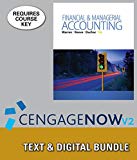
Bundle: Financial & Managerial Accounting, 13th + Working Papers, Volume 1, Chapters 1-15 For Warren/reeve/duchac’s Corporate Financial Accounting, ... 13th + Cengagenow™v2, 2 Terms Access Code
13th Edition
ISBN: 9781337062268
Author: Carl S. Warren, James M. Reeve, Jonathan Duchac
Publisher: Cengage Learning
expand_more
expand_more
format_list_bulleted
Question
Chapter 12, Problem 12.5CP
1.
To determine
Earnings per share (EPS): It refers to the share of earnings earned by the shareholder on each owned. The formula to calculate the earnings per share is as follows:
To Prepare: a table indicating the expected earnings per share on the common stock under each plan.
2.
a.
To determine
To discuss: the factors that should be considered in evaluating the two plans.
b.
To determine
To explain: the plan that offers greater benefit to the present stockholders.
Expert Solution & Answer
Want to see the full answer?
Check out a sample textbook solution
Students have asked these similar questions
Financial Accounting please answer
The Patidar Group manufactures and sells a single product, Product T. Budgeted sales for June are $450,000. Gross Margin is budgeted at 35% of sales dollars. If the net income for June is budgeted at $62,500, the budgeted selling and administrative expenses are?
Accounting MCQ 25
Chapter 12 Solutions
Bundle: Financial & Managerial Accounting, 13th + Working Papers, Volume 1, Chapters 1-15 For Warren/reeve/duchac’s Corporate Financial Accounting, ... 13th + Cengagenow™v2, 2 Terms Access Code
Ch. 12 - Describe the two distinct obligations incurred by...Ch. 12 - Explain the meaning of each of the following terms...Ch. 12 - Prob. 3DQCh. 12 - A corporation issues 26,000,000 of 9% bonds to...Ch. 12 - Prob. 5DQCh. 12 - The following data relate to a 2,000,000, 8% bond...Ch. 12 - Prob. 7DQCh. 12 - Prob. 8DQCh. 12 - Fleeson Company needs additional funds to purchase...Ch. 12 - Prob. 10DQ
Ch. 12 - Prob. 12.1APECh. 12 - Prob. 12.1BPECh. 12 - Issuing bonds at face amount On January 1, the...Ch. 12 - Prob. 12.2BPECh. 12 - Issuing bonds at a discount On the first day of...Ch. 12 - Prob. 12.3BPECh. 12 - Prob. 12.4APECh. 12 - Prob. 12.4BPECh. 12 - Prob. 12.5APECh. 12 - Prob. 12.5BPECh. 12 - Prob. 12.6APECh. 12 - Prob. 12.6BPECh. 12 - Redemption of bonds payable A 1,500,000 bond Issue...Ch. 12 - Prob. 12.7BPECh. 12 - Prob. 12.8APECh. 12 - Prob. 12.8BPECh. 12 - Prob. 12.9APECh. 12 - Prob. 12.9BPECh. 12 - Prob. 12.1EXCh. 12 - Prob. 12.2EXCh. 12 - Prob. 12.3EXCh. 12 - Prob. 12.4EXCh. 12 - Prob. 12.5EXCh. 12 - Prob. 12.6EXCh. 12 - Prob. 12.7EXCh. 12 - Entries for issuing and calling bonds; loss Adele...Ch. 12 - Entries for issuing and calling bonds; gain Emil...Ch. 12 - Entries for installment note transactions On the...Ch. 12 - Prob. 12.11EXCh. 12 - Entries for installment note transactions On...Ch. 12 - Prob. 12.13EXCh. 12 - Prob. 12.14EXCh. 12 - Prob. 12.15EXCh. 12 - Prob. 12.16EXCh. 12 - Present value of amounts due Tommy John is going...Ch. 12 - Present value of an annuity Determine the present...Ch. 12 - Prob. 12.19EXCh. 12 - Prob. 12.20EXCh. 12 - Prob. 12.21EXCh. 12 - Prob. 12.22EXCh. 12 - Amortize discount by interest method On the first...Ch. 12 - Prob. 12.24EXCh. 12 - Prob. 12.25EXCh. 12 - Prob. 12.26EXCh. 12 - Prob. 12.1APRCh. 12 - Prob. 12.2APRCh. 12 - Bond premium, entries for bonds payable...Ch. 12 - Prob. 12.4APRCh. 12 - Prob. 12.5APRCh. 12 - Prob. 12.6APRCh. 12 - Prob. 12.1BPRCh. 12 - Prob. 12.2BPRCh. 12 - Prob. 12.3BPRCh. 12 - Prob. 12.4BPRCh. 12 - Prob. 12.5BPRCh. 12 - Prob. 12.6BPRCh. 12 - Prob. 12.1CPCh. 12 - Prob. 12.2CPCh. 12 - Prob. 12.3CPCh. 12 - Preferred stock vs. bonds Xentec Inc. has decided...Ch. 12 - Prob. 12.5CPCh. 12 - Prob. 12.6CP
Knowledge Booster
Learn more about
Need a deep-dive on the concept behind this application? Look no further. Learn more about this topic, accounting and related others by exploring similar questions and additional content below.Similar questions
- Explore the concept of accounting flexibility and its impact on the reliability and usefulness of financial information. While adaptability in accounting methods can allow organizations to better reflect their unique circumstances, it may also introduce the risk of selective application or manipulation. Discuss the appropriate balance between standardization and customization in accounting practices.arrow_forwardGeneral accountingarrow_forwardNeed answerarrow_forward
arrow_back_ios
SEE MORE QUESTIONS
arrow_forward_ios
Recommended textbooks for you
 Financial AccountingAccountingISBN:9781337272124Author:Carl Warren, James M. Reeve, Jonathan DuchacPublisher:Cengage Learning
Financial AccountingAccountingISBN:9781337272124Author:Carl Warren, James M. Reeve, Jonathan DuchacPublisher:Cengage Learning Financial AccountingAccountingISBN:9781305088436Author:Carl Warren, Jim Reeve, Jonathan DuchacPublisher:Cengage Learning
Financial AccountingAccountingISBN:9781305088436Author:Carl Warren, Jim Reeve, Jonathan DuchacPublisher:Cengage Learning EBK CONTEMPORARY FINANCIAL MANAGEMENTFinanceISBN:9781337514835Author:MOYERPublisher:CENGAGE LEARNING - CONSIGNMENT
EBK CONTEMPORARY FINANCIAL MANAGEMENTFinanceISBN:9781337514835Author:MOYERPublisher:CENGAGE LEARNING - CONSIGNMENT Financial Reporting, Financial Statement Analysis...FinanceISBN:9781285190907Author:James M. Wahlen, Stephen P. Baginski, Mark BradshawPublisher:Cengage Learning
Financial Reporting, Financial Statement Analysis...FinanceISBN:9781285190907Author:James M. Wahlen, Stephen P. Baginski, Mark BradshawPublisher:Cengage Learning

Financial Accounting
Accounting
ISBN:9781337272124
Author:Carl Warren, James M. Reeve, Jonathan Duchac
Publisher:Cengage Learning

Financial Accounting
Accounting
ISBN:9781305088436
Author:Carl Warren, Jim Reeve, Jonathan Duchac
Publisher:Cengage Learning

EBK CONTEMPORARY FINANCIAL MANAGEMENT
Finance
ISBN:9781337514835
Author:MOYER
Publisher:CENGAGE LEARNING - CONSIGNMENT

Financial Reporting, Financial Statement Analysis...
Finance
ISBN:9781285190907
Author:James M. Wahlen, Stephen P. Baginski, Mark Bradshaw
Publisher:Cengage Learning


Internal Rate of Return (IRR); Author: The Finance Storyteller;https://www.youtube.com/watch?v=aS8XHZ6NM3U;License: Standard Youtube License